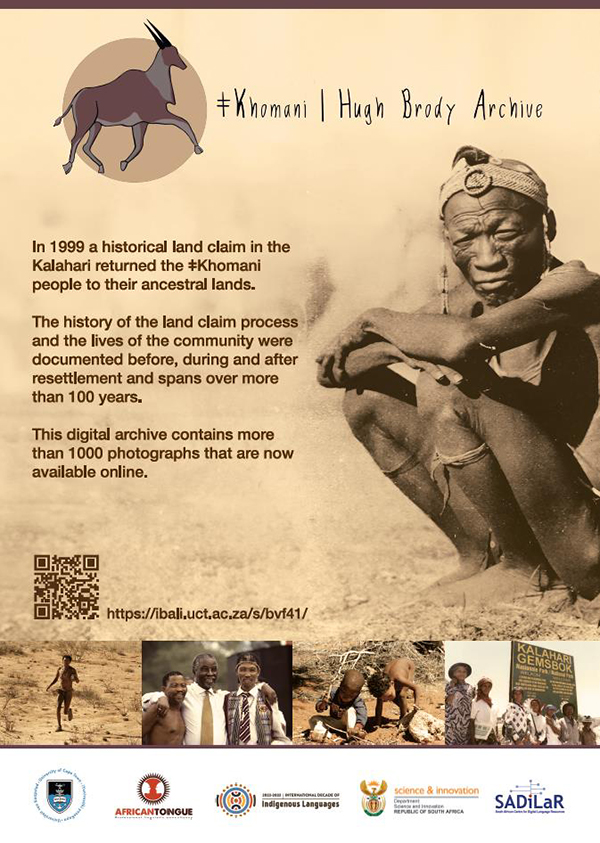A research project, funded by the South African Centre for Digital Language Resources (SADiLaR) at the North-West University (NWU), has helped realise the long-held dream of South Africa’s ǂKhomani community to share their proud history with the rest of the world.
Dr Kerry Jones, director of African Tongue and research lead on the project, has worked tirelessly with her research partners in the southern Kalahari to identify, digitise and develop metadata for a large body of historical photos that are held at the University of Cape Town’s (UCT) Special Collections Library, as part of the ǂKhomani | Hugh Brody Collection
“It is the first project on the African continent to be registered with UNESCO's International Decade of Indigenous Languages,” Dr Jones remarks. “These resources are not just a national treasure but a global one.”
The ǂKhomani are among the first known people to live in the southern region of the Kalahari, in the far northwest corner of South Africa. They have lived as hunters and gatherers in this vast desert landscape for generations and yet their proud heritage and rich language was nearly lost to their descendants and the world.
“This special collection holds all the materials that were generated over 15 years of work with the ǂKhomani by various researchers,” says Dr Jones. “It also includes over 130 hours of original film footage, detailed local maps, family trees, audio clips and transcripts of oral history collected in four different languages (Nǀuu, Nama, Kora and Afrikaans) – all of which is still to be digitised in the near future, pending availability of funding.”
According to Dr Jones, digitising the more than 1 000 photos - which span over 120 years, from the Kalahari to Kagga Kamma and back again - involved language verification, orthography standardisation, and the development of metadata for all photographs in the collection.
"This includes the standardisation throughout the collection of traditional names transcribed in N|uu, Kora, or Khoekhoegowab. For example, in instances where a photograph has a description of places or names of people, these will be transcribed in the original source language using modern orthography practices, using standardised Unicode throughout the collection to make the content uniform and digitally findable," she explains.
A proud partnership with SADiLaR
“Our team is very grateful for the support from SADiLaR to do this very meaningful work,” Dr Jones adds. “This is African Tongue's second collaboration with SADiLaR. The first was with Prof Menno van Zaanen in developing the N|uu Namagowab Afrikaans English dictionary and associated web portal and app Saasi Epsi. Our dictionary has since become an award-winning publication that we are very proud of.
“We hope that this digital archive will be just as impactful and noteworthy and that the working relationship between African Tongue and SADiLaR will continue to grow from strength to strength. It is our priority to produce quality language and heritage outputs to assist with documentation, preservation, and maintenance of our nation's endangered languages.
Extensive community consultation
Dr Jones worked closely with the ǂKhomani community to help identify the people and places in the photos.
The project also entailed developing a digital project showcase on Ibali, UCT's digital collections platform, using Omeka-S software.
“We developed instructional material for the local community and general public on how to access this photo archive in both English and Afrikaans, Afrikaans being the lingua franca of the Kalahari. We also presented training sessions and workshops on how to work with this new resource to local community members, librarians, and educators in both Upington and the Kalahari,” adds Dr Jones.
Showcasing the ǂKhomani people’s unique heritage
Completing the first portion of the digital ǂKhomani | Hugh Brody Archive comes as a huge relief to Jones and her hardworking team.
“We hope that this example will show what we are capable of and showcase South Africa’s unique heritage and linguistic diversity (which will be more evident when the transcript files go live on Ibali in September 2024). We still have a long way to go with the rest of the collection but we're working on it. I think it's very important to prioritise community engagement and accessible public feedback. It's been so many years since the inception of this work and the ǂKhomani people and the general public can finally access these resources on a user-friendly platform.”
* Visit the ǂKhomani | Hugh Brody Archive here. The photo component of the collection went live in March 2024, and the next component, ‘Films and Transcripts’ is expected to be launched in September 2024.

